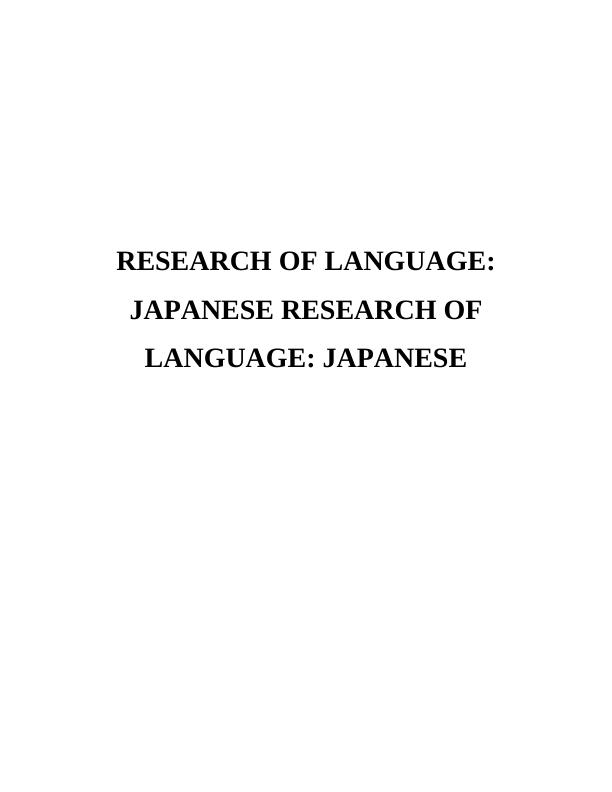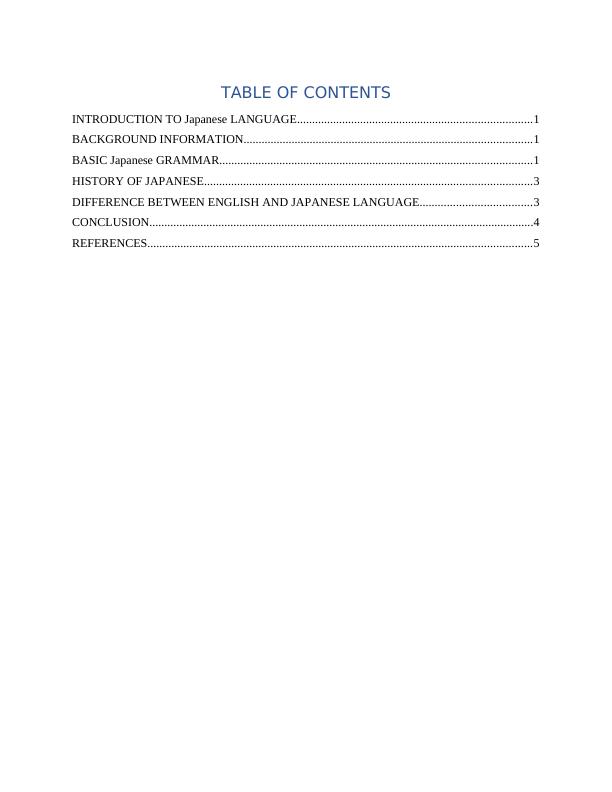History of Japanese Language
Added on 2020-06-04
9 Pages2255 Words59 Views
RESEARCH OF LANGUAGE:JAPANESE RESEARCH OFLANGUAGE: JAPANESE

TABLE OF CONTENTSINTRODUCTION TO Japanese LANGUAGE..............................................................................1BACKGROUND INFORMATION................................................................................................1BASIC Japanese GRAMMAR........................................................................................................1HISTORY OF JAPANESE.............................................................................................................3DIFFERENCE BETWEEN ENGLISH AND JAPANESE LANGUAGE.....................................3CONCLUSION................................................................................................................................4REFERENCES................................................................................................................................5

INTRODUCTION TO Japanese LANGUAGEJapanese is one of the most challenging language to learn and is mostly spoken by nativepeople of Japan. On enumerating this ratio, there exists only 130 million people in the world whofluently speaks in Japanese language. Much linguistic debate is concerning the agenda behindlearning Japanese language. As a result, to which, Japan is specified to be a language of onlyJapanese. Japan having the strongest economic status is specified to be an exclusive nation withmost progressive thinking (Sasit, 2015). This ultimately resulted in much technical advancementin their country. The term is pronounced as Nippon or Nihon in Japanese where their people arecalled as Nihonjin and its language is known as Nihongo. Japanese comprising with threedistinct characters namely Hiragana, Katakana and Kanji forms the writing system of Japanwhere all of these acts as its main scripts. However, a significant part of their language has alsobeen borrowed from Portuguese, German, Chinese, Dutch and most newly, from English as well.BACKGROUND INFORMATIONDespite of the fact where Japanese is mostly spoken by its natives, there together existsmany migrant speakers who are spread across the regions of Western Hemisphere. Also, thereexists nearly 2 million students who are mostly spread in the regions of South Korea, US andAustralia (Banno and Kuroe, 2016). A much interesting thing about Japanese language is it’s theonly official language in Japan and none of the Japanese people prefers to speak in English. Thisindicates a huge difference among both these languages where English having only 26 letters inits terminology, Japanese is referred to have 3 distinct set of characters.These are Hiragana as the most basic one and comprising with 46 characters that areinitially based on another script named Kanji and are relatable to the vowels of English languagethat are, a, e, i, o and u. Katakana on other hand is similar to Hiragana and consists of 46 suchcharacters with a major difference of their shapes (Kamermans, 2017). It is where Katakana ismore straight and angular, unlike Hiragana which is more cursively written. Lastly, the mostapprehensive Kanji due to its major derivation from Chinese and is thus very different from bothHiragana and Katakana where Kanji implies the meaning rather signifying the sound like theother two. BASIC Japanese GRAMMARBefore referring to learn the basic Japanese grammar, it is important to go through itswriting system that consists of its 3 leading scripts namely Hiragana, Katakana and lastly, Kanji1

End of preview
Want to access all the pages? Upload your documents or become a member.
Related Documents
Language and Society in Japan: Recent Changes and Implicationslg...
|4
|699
|72
cross cultural management - essaylg...
|15
|3282
|43
